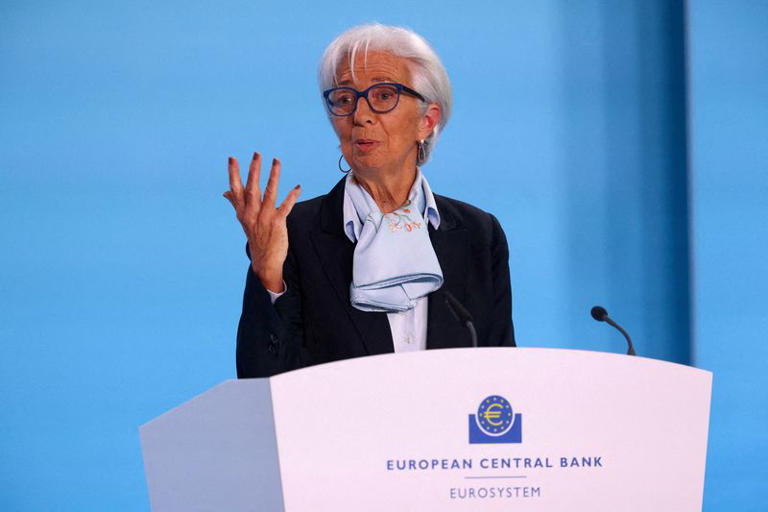The European Central Bank (ECB) has taken a decisive step by cutting interest rates for the first time in nearly five years. This move, announced on Thursday, is a significant policy shift aimed at lowering borrowing costs as inflation shows signs of receding after several years of aggressive rate hikes. The decision places the ECB ahead of the US Federal Reserve and the Bank of England in adjusting its monetary policy to support economic growth.
Details of the Rate Cut
- Benchmark Rate Adjustment: The ECB has reduced its benchmark interest rate from an all-time high of 4% to 3.75%. This adjustment impacts the 20 countries that use the euro, aiming to ease the financial burden on both companies and consumers who have been feeling the pinch of higher borrowing costs.
- Timing: The decision to cut rates comes at a crucial juncture when inflation is easing. The move is designed to stimulate economic activity by making borrowing cheaper without rekindling significant inflationary pressures.
Economic Context and Implications
- Inflation Trends: The ECB’s rate cut reflects cautious optimism regarding inflation trends. While there has been progress in reducing inflation, domestic price pressures remain strong, primarily due to elevated wage growth. The ECB anticipates that inflation will remain above its target well into the next year.
- Relief for Borrowers: The reduction in interest rates is expected to provide much-needed relief to businesses and consumers. Lower borrowing costs can boost investment and consumer spending, which are critical for economic growth, especially after the rapid increase in interest rates since late 2021 that tightened financial conditions significantly.
Caution from the ECB
Despite the rate cut, the ECB has emphasized that the battle against inflation is not yet over:
- Future Rate Decisions: The ECB stated that it is not committed to a specific path for future rate cuts. Instead, it will take a “data-dependent and meeting-by-meeting approach” to its monetary policy decisions. This means that future actions will be closely tied to ongoing economic data and inflation trends.
- Christine Lagarde’s Statement: ECB President Christine Lagarde, at a press conference, highlighted the central bank’s cautious approach. She pointed out that while progress has been made in controlling inflation, significant domestic price pressures persist. Lagarde stressed the importance of flexibility, indicating that the ECB is not precommitting to a particular rate path.
Visual and Symbolic Gestures
- Lagarde’s Symbolic Necklace: During her press conference, President Lagarde wore a necklace with the words “In charge,” symbolizing her authoritative role and the ECB’s commitment to decisive leadership. This visual cue underscored the ECB’s resolve in navigating the economic landscape and implementing necessary monetary policies.
Broader Monetary Policy Landscape
The ECB’s rate cut is a significant move within the broader context of global monetary policy, where central banks are balancing the dual mandates of supporting economic growth and controlling inflation:
- Comparative Actions: By reducing rates before the Federal Reserve and the Bank of England, the ECB sets a proactive example that could influence other central banks. This move underscores the ECB’s responsiveness to changing economic conditions and its readiness to adjust policies to support the eurozone economy.
Potential Impact on the Economy
- Consumer and Business Relief: The rate cut is expected to lower the cost of borrowing for both consumers and businesses. For consumers, this could mean more affordable mortgage rates and personal loans, leading to increased spending power. For businesses, lower borrowing costs can encourage investment in capital, expansion, and innovation, potentially leading to job creation and economic growth.
- Financial Markets Reaction: Financial markets typically react positively to interest rate cuts, as they signal an easing of monetary policy that can stimulate economic activity. However, the market response will also depend on investors’ confidence in the ECB’s ability to manage inflation while supporting growth.
Long-Term Considerations
- Sustainable Growth: The ECB’s cautious stance on future rate cuts highlights the need for a balanced approach. Sustainable economic growth requires managing inflation without stifling investment and consumer spending.
- Monitoring Economic Indicators: The ECB’s commitment to a data-dependent approach means that it will closely monitor key economic indicators, including inflation rates, wage growth, and overall economic performance, to guide future policy decisions.
The European Central Bank’s decision to cut interest rates marks a significant shift in its monetary policy, aimed at supporting economic growth amid easing inflation. While the rate cut offers immediate relief to borrowers, the ECB’s cautious stance on future cuts underscores the ongoing challenges of managing inflationary pressures. President Christine Lagarde’s commitment to a flexible, data-driven approach ensures that the ECB remains adaptable to future economic developments. This strategic move highlights the ECB’s leadership in monetary policy adjustments within a complex global economic environment, setting a precedent that may influence other central banks’ decisions.

